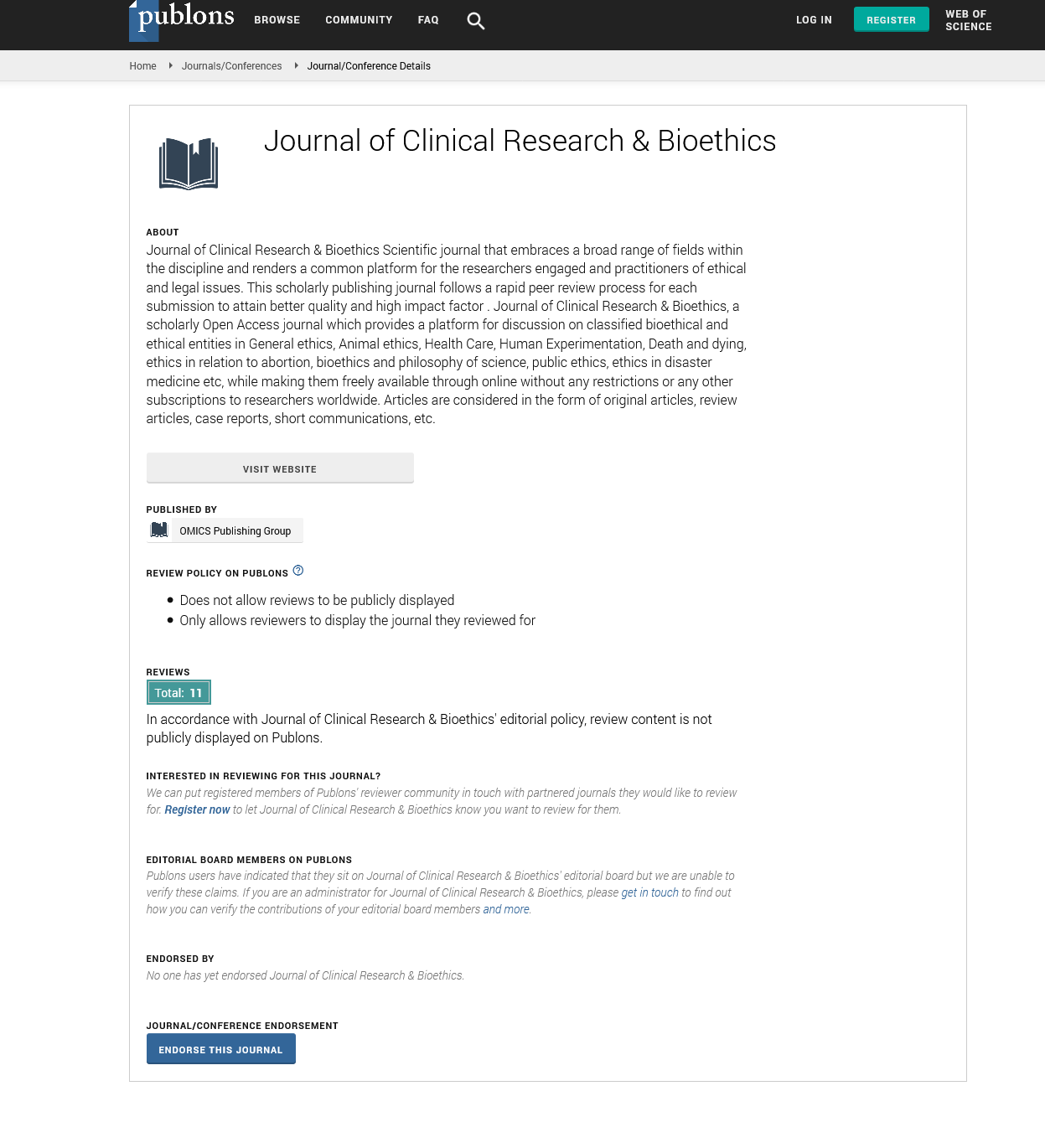Indexed In
- Open J Gate
- Genamics JournalSeek
- JournalTOCs
- RefSeek
- Hamdard University
- EBSCO A-Z
- OCLC- WorldCat
- Publons
- Geneva Foundation for Medical Education and Research
- Google Scholar
Useful Links
Share This Page
Journal Flyer

Open Access Journals
- Agri and Aquaculture
- Biochemistry
- Bioinformatics & Systems Biology
- Business & Management
- Chemistry
- Clinical Sciences
- Engineering
- Food & Nutrition
- General Science
- Genetics & Molecular Biology
- Immunology & Microbiology
- Medical Sciences
- Neuroscience & Psychology
- Nursing & Health Care
- Pharmaceutical Sciences
Commentary - (2024) Volume 15, Issue 5
Analyzing the Role of Organoids in Ovarian Cancer Development
Zhongjian Liu*Received: 26-Aug-2024, Manuscript No. JCRB-24-27156; Editor assigned: 28-Aug-2024, Pre QC No. JCRB-24-27156 (PQ); Reviewed: 11-Sep-2024, QC No. JCRB-24-27156; Revised: 18-Sep-2024, Manuscript No. JCRB-24-27156 (R); Published: 25-Sep-2024, DOI: 10.35248/2155-9627.24.15.503
Description
Ovarian cancer remains one of the deadliest gynecological malignancies due to its late diagnosis and complex biological behavior. Despite advancements in treatment, understanding the molecular and cellular mechanisms driving ovarian carcinogenesis has been a major challenge. Recently, organoid technology has emerged as an advanced tool that provides new insights into the mechanisms underlying ovarian cancer development, progression and drug resistance. This article describes how organoid models are used to resolve the complex of ovarian carcinogenesis and their potential applications in personalized medicine.
Understanding ovarian carcinogenesis
Ovarian carcinogenesis is a multistep process that involves genetic mutations, epigenetic changes and interactions between cancer cells and their surrounding microenvironment. The majority of ovarian cancers originate from the epithelium, particularly from the fallopian tube epithelium and ovarian surface epithelium. High-Grade Serous Carcinoma (HGSC) is the most common and aggressive subtype, often linked to mutations in lead tumor suppressor genes such as TP53 and BRCA1/2. However, the heterogeneity of ovarian cancer both between different patients and within tumors themselves makes it difficult to generalize findings from traditional cell lines or animal models to real patient outcomes.
Organoids, three-dimensional (3D) cell culture systems derived from patient tissues, represent a potential solution to this problem. Unlike two-dimensional (2D) cultures, which fail to replicate the complex architecture of tumors, organoids maintain the tissue-specific structures and functions seen in vivo. As a result, they suggest more physiologically relevant model for studying cancer initiation and progression.
Organoid: A new model for studying cancer
Organoid technology allows for the generation of 3D miniaturized organs from stem cells or tumor tissues. These models recapitulate the cellular diversity, tissue architecture and genetic mutations found in human tumors, making them ideal for studying cancer biology. In ovarian cancer research, organoids have been generated from various sources, including fallopian tube cells, normal ovarian tissue and malignant tumor tissues.
The advantage of organoids is their ability to model the entire process of ovarian carcinogenesis. Researchers can observe the transition from normal epithelium to precancerous lesions and, eventually, to fully developed tumors. Organoids also capture the genetic and phenotypic heterogeneity of ovarian cancer, suggesting a more accurate representation of tumor complexity compared to traditional 2D cell lines.
Insights into the mechanisms of ovarian carcinogenesis
Organoids have provided invaluable insights into the molecular mechanisms driving ovarian carcinogenesis. For example, studies using organoids derived from the fallopian tube epithelium have demonstrated how mutations in BRCA1/2 and TP53 contribute to the early stages of tumorigenesis. These organoids represent the fallopian tube environment where high-grade serous carcinomas are believed to originate, helping researchers understand how the transformation from normal cells to malignant cells occurs.
Another area where organoids have advanced knowledge is the study of tumor-stroma interactions. The ovarian tumor microenvironment is composed of cancer cells, stromal cells, immune cells and the extracellular matrix. This complex ecosystem plays a critical role in cancer progression and drug resistance. By co-culturing cancer organoids with stromal cells, researchers can study how these interactions influence tumor growth and metastasis. For instance, it has been found that Cancer-Associated Fibroblasts (CAFs) in the stroma can secrete factors that promote cancer cell proliferation and invasion, suggesting potential new therapeutic targets.
Moreover, ovarian cancer organoids have been used to model chemoresistance, a major obstacle in the treatment of ovarian cancer. By exposing organoids to chemotherapy drugs, researchers have identified molecular pathways involved in drug resistance, such as alterations in DNA damage response pathways and Epithelial-to-Mesenchymal Transition (EMT). These findings could lead to the development of more effective therapies for patients with drug-resistant ovarian cancer.
Personalized medicine and drug screening
One of the most exciting applications of organoid technology is its potential to revolutionize personalized medicine. Ovarian cancer patients often receive similar treatment regimens, but not all respond equally well due to the heterogeneity of the disease. Patient-Derived Organoids (PDOs) suggest a platform for testing the effectiveness of various drugs on an individual basis, allowing for more personalized treatment strategies.
PDOs can be generated from a patient’s tumor biopsy and researchers can expose these organoids to different chemotherapeutic agents or targeted therapies. By assessing which drugs are most effective at killing the cancer cells in the organoids, clinicians can customize treatment plans to the specific biology of each patient’s tumor. This approach not only improves the chances of treatment success but also spares patients from unnecessary side effects associated with ineffective therapies.
Organoids also provide a valuable tool for high-throughput drug screening. Pharmaceutical companies can use organoid models to test large libraries of compounds for their potential to inhibit ovarian cancer growth. This has the potential to accelerate the discovery of new therapies and reduce the reliance on animal models, which often fail to accurately predict human responses to drugs.
Challenges and future directions
Despite the potential advances, there are still challenges to overcome in the use of organoids for ovarian cancer research. One limitation is the difficulty in recapitulating the full complexity of the tumor microenvironment in vitro. While organoids capture many aspects of cancer biology, they may not fully represent the interactions between cancer cells and immune cells, which play an important role in tumor immune evasion and response to immunotherapy.
Another challenge is the scalability of organoid production. The process of generating and maintaining organoids can be laborintensive and costly, limiting their widespread use. However, advances in bioengineering and automation may help overcome these hurdles, making organoids more accessible to a broader range of researchers.
Citation: Liu Z (2024). Analyzing the Role of Organoids in Ovarian Cancer Development. J Clin Res Bioeth. 15:503.
Copyright: © 2024 Liu Z. This is an open-access article distributed under the terms of the Creative Commons Attribution License, which permits unrestricted use, distribution, and reproduction in any medium, provided the original author and source are credited.

